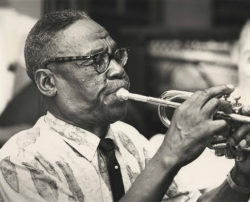Punch Miller
“Punch” Miller, also known as “Kid Punch,” was a New Orleans traditional jazz, blues, and brass band trumpeter and vocalist.

Courtesy of Louisiana State Museum
Ernest "Punch" Miller. Fletcher, George (Photographer)
Ernest “Punch” Miller, also known as “Kid Punch,” was a New Orleans traditional jazz, blues, and brass band trumpeter and vocalist perhaps best remembered for his genre-bending, blues-tinged performance aesthetics and his signature fast fingering. Miller was one of many New Orleans musicians whose career seemed larger than life: he once received a trumpet as a gift from Louis Armstrong, he led one of the first Preservation Hall bands, and his last public performance was at the New Orleans Jazz & Heritage Festival with Dizzy Gillespie looking on. Miller was the subject of a television documentary called ’Til the Butcher Cuts Him Down, filmed only months before his death in 1971.
Miller was born as Ernest P. Burden on June 10, 1894, in Raceland, Louisiana. The nickname “Punch” was given to him early in life by family and friends, as his twin sister was named Ernestine Judy (“Punch and Judy” puppets were popular at the time). Miller’s stepfather was in a brass band, and Ernest received his first musical instrument—a drum—from him. Then came the cornet and, later, trombone and trumpet, for which he received lessons from a number of different musicians, including the legendary Professor James Humphrey. While still in his teens, Miller played informally with local dance and pick-up bands in Raceland and surrounding rural areas. A chance encounter gave Miller the opportunity to sit in with Bunk Johnson’s band during a brief train-stop performance at a local depot. In 1917 Miller performed with Jack Carey in New Orleans before entering military service.
During World War I, Miller was an army corporal and bugler, and his time in the military afforded him additional training on his instrument. After his discharge he settled in New Orleans and formed his own band, Delegates of Pleasure, which would quickly become one of the more popular groups in the city. Miller’s first recording was made in New Orleans accompanying Billy and Mary Mack in 1925. In 1925 or 1926, Miller settled in Chicago, the city that would become his home base for the next two decades. During his Chicago years he performed with Freddie Keppard, Tiny Parham, and Al Wynn. He also made appearances with his own band, played frequent vaudeville tours with Mack’s Merrymakers, and traveled with dance bands led by Jelly Roll Morton and Fate Marable. Miller would sit in for Louis Armstrong with Erskine Tate’s Orchestra at the Vendome Theater in Chicago. In ’Til the Butcher Cuts Him Down, Miller claims that it was his heavy drinking that got him discharged from Jelly Roll Morton’s band, and it was a problem he would struggle with throughout his life.
Miller remained in Chicago until the mid-1940s, accompanying blues artists Big Bill Broonzy and Tampa Red on recordings. In 1947 a brief tour took Miller to New York City, where he was featured on the first episode of Rudi Blesh’s radio series, This Is Jazz. Miller played often for touring carnivals and circuses and in that way performed with early rock ’n’ roll bands of the mid-1950s. Miller also did work with Silas Green in the 1950s. In 1956 Miller returned to New Orleans to live and work full-time, taking on handyman jobs to supplement music gigs.
As for so many other musicians of the earliest generation of jazz, the late 1950s and 1960s were an important time. Miller’s friend Beansie Fauria introduced him to the Associated Artists Gallery jazz sessions in the French Quarter, and soon Miller was playing there several times a week. These sessions were instrumental in leading to the creation ofPreservation Hall in 1961.
Miller was recorded by Folkways in 1959 and by the Icon label in 1960. After the formation of Preservation Hall, he also recorded for Atlantic and Imperial. A tour of Japan with George Lewis came in 1963.
He died in New Orleans on December 2, 1971.
